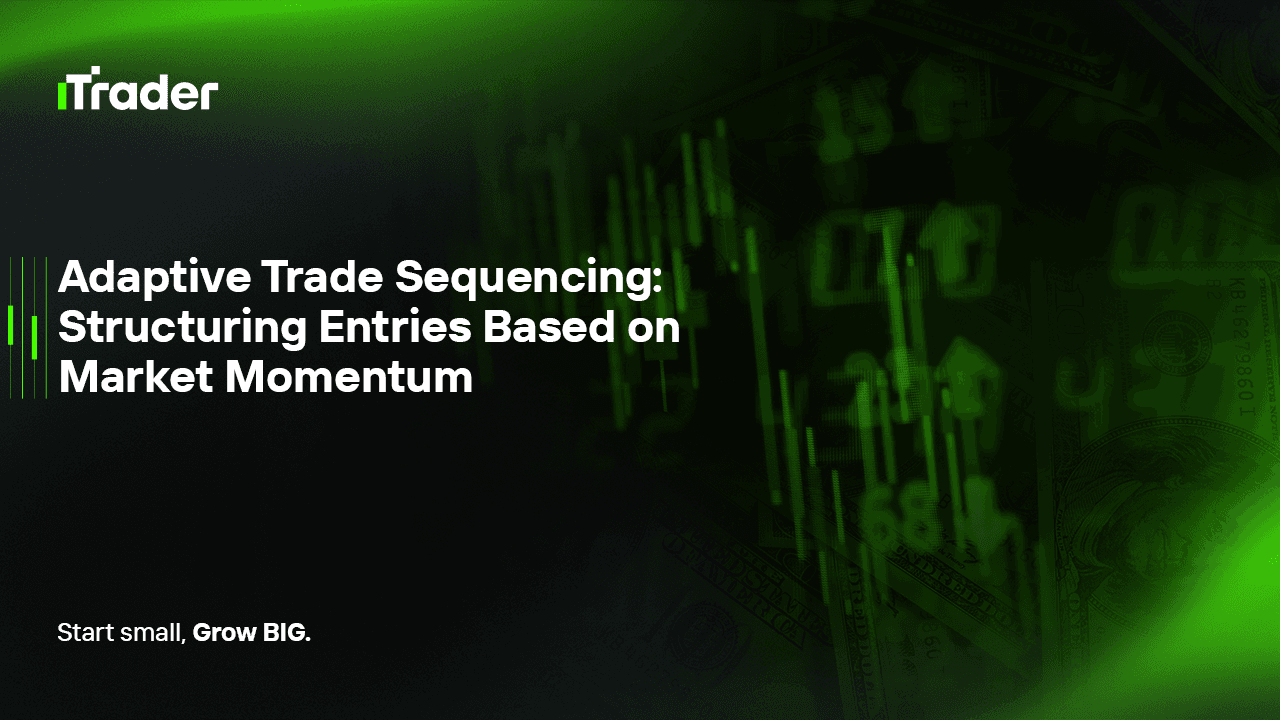2025-10-27
In forex trading, many traders obsess over finding the “perfect entry.” Yet at a professional level, an entry is not a single action — it’s part of a managed sequence that evolves with market flow. A market impulse — driven by momentum, liquidity flow, and order imbalance — is a dynamic burst of price movement. Designing your entry sequence to align with these impulses is known as sequencing-based trade planning.

For prop traders, this approach goes beyond identifying one profitable setup. It’s about using market energy to maximize efficiency, compound gains, and manage risk dynamically through every phase of a move.
A trade sequence represents a structured series of entries and exits built around one market narrative or trading idea.
In essence:
This marks the transition from static entry to dynamic execution — from reacting to the market to moving with it.
Market impulses — sharp directional movements often followed by short consolidations — emerge when liquidity and momentum converge.
They typically involve:
After the impulse, a pullback or re-accumulation phase often follows. Recognizing where you are in this impulse cycle is the foundation for effective sequencing.
Dynamic sequencing is the practice of managing entries in phases that adapt to market confirmation and momentum.
The typical structure includes:
This structure — sometimes referred to as an Adaptive Layered Entry Model — isn’t about averaging down. Instead, it’s about compounding into strength, using the market’s own energy to enhance position efficiency.
Each step builds on information from the previous one, maintaining flexibility without compromising control.
Dynamic sequencing can be modeled algorithmically using key quantitative variables such as:
A simplified decision logic may look like this:
This framework represents quantitative impulse detection — a systematic way to align trade execution with the evolving market structure.
No algorithm can fully interpret the context behind every impulse. Human judgment adds the nuance required for adapting dynamically.
Not all impulses are equal. A post-FOMC breakout carries a different weight than a random Asian-session spike.
Experienced traders can distinguish between sustainable momentum and short-lived noise — a skill algorithms often lack.
Impulses can fade quickly. Traders can apply time filters to delay or confirm entries — for example, waiting for a five-minute structure to form before engaging.
Adding to winning positions feels counterintuitive to most traders, yet in momentum-driven markets, it’s often the most efficient way to compound gains.
Human awareness allows the trader to execute this logically, not emotionally.
In the prop trading environment, dynamic sequencing helps balance risk control and equity acceleration — two critical performance pillars.
By scaling in progressively, traders prevent risk from clustering in a single entry point, reducing the chance of breaching daily loss or drawdown limits.
Incremental entries during valid impulses improve capital utilization efficiency. Rather than committing full risk upfront, capital is deployed where the market confirms its direction.
Prop traders who recognize the “impulse” in their equity curve can align their trade sequencing accordingly — expanding during growth phases and contracting during stagnation.
This transforms their approach from reactive to self-adaptive.
Instead of testing only setups, evaluate the sequencing logic — e.g., “How effective were my momentum-based add-ons after the first entry?”
Test your sequencing performance across different regimes (range-bound vs. trending) to ensure adaptability.
Monitor execution variables like latency, slippage, and spread changes that affect the integrity of sequencing — essential in automated or semi-automated prop environments.
Modern AI-driven execution systems are now learning to manage trade sequences in real time.
This integration of algorithmic intelligence with trader intuition — the Human-in-the-Loop framework — defines the next evolution of professional execution systems.
2025 Ай Трейдер Глобал ХХК | Компанийн бүртгэлийн дугаар: 15962
Ай Трейдер Глобал ХХК нь Комор улсын Анжуан арал дахь Мутсамуду хотын Хамчакод байрлалтай. Тус компани нь Коморын Үнэт Цаасны Хорооноос (Securities Commission of the Comoros) олгосон L15962/ITGL дугаартай тусгай зөвшөөрлийн хүрээнд үйл ажиллагаа явуулдаг.
Ай Трейдер Глобал ХХК нь “iTrader” нэрийн дор үйл ажиллагаа явуулдаг бөгөөд (Форекс) арилжааны үйл ажиллагаа явуулах эрхтэй. Компанийн лого, барааны тэмдэг, вэбсайт нь зөвхөн Ай Трейдер Глобал ХХК компанийн өмч юм.
Ай Трейдер Глобал ХХК -ийн охин компани болох : iTrader Global Pty Ltd, Австралийн компанийн бүртгэлийн дугаар (ACN): 686 857 198. Энэ компани нь Opheleo Holdings Pty Ltd компанийн албан ёсны төлөөлөгч бөгөөд Австралийн санхүүгийн үйлчилгээний төлөөлөгчийн дугаар: 001315037 -тай. Австралийн санхүүгийн үйлчилгээний лицензийн дугаар: 000224485 -тай Level 1, 256 Rundle St, Adelaide, SA 5000 хаягт байршдаг. Анхааруулга: Энэ байгууллага нь энэхүү вэбсайт дээр болон дамжуулан арилжаалагдаж буй санхүүгийн (арилжааны) хэрэгсэл нийлүүлэгч биш бөгөөд ямар нэгэн хариуцлага хүлээхгүй болно.
Эрсдэлийн сэрэмжлүүлэг: CFD арилжааны хөшүүргийн улмаас хөрөнгөө хурдан алдах өндөр эрсдэлтэй тул бүх хэрэглэгчдэд тохиромжгүй байдаг.
Фанд, CFD болон бусад өндөр xөшүүрэгтэй арилжаа нь хэрэглэгчээс нарийн төвөгтэй ойлголтуудын талаар тусгай мэдлэг шаарддаг. Хөшүүрэгтэй арилжаанд оролцогчдын 84.01% нь алдагдал хүлээдгийг судалгаанууд харуулдаг тул хөшүүрэгтэй арилжаанд орохоос өмнө хөрөнгөө алдах маш өндөр эрсдэлтэй болохыг анхаарна уу.
iTrader нь аливаа иргэн, хуулийн этгээдийн өмнө xөшүүрэгтэй арилжааны эрсдэл, алдагдал, бусад хохирлыг бүхэлд нь хариуцахгүй болохыг мэдэгдэж байна.
Энэхүү веб сайтын мэдээ, мэдээлэл нь зөвхөн мэдлэг түгээх зорилготой тул хэрэглэгч та бие даан шийдвэр гаргана уу.
Хязгаарлалт: iTrader нь вэбсайт болон үйлчилгээгээ тухайн орны хууль тогтоомж, дүрэм журмаар хориглосон орнуудад оршин суугчдад чиглүүлдэггүй. Хэрэв та энэхүү вэбсайтыг ашиглахыг хориглосон оронд байгаа бол вэбсайт болон үйлчилгээг ашиглахдаа тухайн орны хууль тогтоомжид нийцэж байгаа эсэхийг шалгах үүрэгтэй. iTrader нь вэбсайтынхаа мэдээлэл бүх оронд тохиромжтой эсэхийг баталгаажуулдаггүй.
Ай Трейдер Глобал ХХК нь зарим улс орны иргэдэд үйлчилгээ үзүүлэхээс татгалздаг болно. Жишээлбэл: АНУ, Орос, Бразил, Канада, Израйл, Иран.